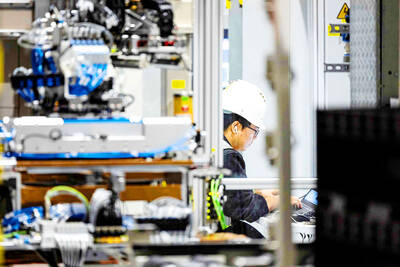IKEA was onto something when it opened its first South Korean store, its largest anywhere, in late 2014.
Home furnishing chains are a bright spot in a sluggish South Korean economy, tapping demand from the rising share of people who are living alone and spending more to make their dwellings attractive and comfortable.
Local market leader Hanssem Co Ltd, with sales of more than US$1 billion in 2014, saw a 31 percent increase in revenue for the first nine months of last year and a doubling in its share price for the year as it opened 27 of its larger stores in 2014 and last year. Shinsegae Co Ltd’s Jaju chain opened 10 stores last year, bringing its total to 149.

Photo: Reuters
Swedish giant IKEA, whose single store on the outskirts of Seoul generated US$260 million in its first year, expects to spend 1.2 trillion won (US$997 million) to open five more South Korea stores by 2020 — one more than earlier planned.
South Korea is following a path seen in the US and Japan, with people spending more on home decoration as per-capita GDP rises, analysts say.
“Four or five years ago, people thought home decorating was only for rich people,” said Ock Soo, 32, who founded Webzine Rooomers and conducts decorating classes attended mostly by singles.
“Now home decoration is for everyone, as more people are living alone and for longer periods,” she said.
Home decorating shows known as “jipbang” have been proliferating on TV, including “Old House, New House” and “My Room’s Dignity,” both of which debuted in December last year.
A fast-graying South Korean population and heavy household debt, at 1.7 times annual disposable income, make property investment less attractive, prompting homeowners and renters to spend instead on making their existing dwellings more liveable. South Korea’s working-age population is set to peak this year.
“People no longer see houses as an investment, but as an object of utilization,” said Lee Gwang-soo, an analyst at Mirae Asset Securities. “People start decorating their homes because they now have to ‘live’ in them.”
Last year, South Koreans spent 12 trillion won on home interior decoration, including floors, walls, doors, kitchen and bathroom fixtures and labor, up from about 9 trillion won in 2014 and forecast to grow to 27 trillion won by next year, according to Mirae Asset Securities.
Those figures exclude furniture and off-the-shelf items, which make up the bulk of sales at retailers like IKEA and H&M Hennes & Mauritz AB’s H&M Home, and came despite economic growth that slowed to 2.6 percent last year, from 3.3 percent.
Korea Investment & Securities estimates the domestic furniture market is worth about 8 trillion won, with kitchen items counting for another 3 trillion to 4 trillion won.
The share of single-person households in the country rose to an estimated 27 percent last year from 20 percent in 2005, according to Statistics Korea, and is forecast to reach 31 percent in 2025 as younger people delay getting married and having children in the fastest-ageing industrialized country.
People living on their own spend a larger share of their incomes on consumption, including decoration.

CHIP RACE: Three years of overbroad export controls drove foreign competitors to pursue their own AI chips, and ‘cost US taxpayers billions of dollars,’ Nvidia said China has figured out the US strategy for allowing it to buy Nvidia Corp’s H200s and is rejecting the artificial intelligence (AI) chip in favor of domestically developed semiconductors, White House AI adviser David Sacks said, citing news reports. US President Donald Trump on Monday said that he would allow shipments of Nvidia’s H200 chips to China, part of an administration effort backed by Sacks to challenge Chinese tech champions such as Huawei Technologies Co (華為) by bringing US competition to their home market. On Friday, Sacks signaled that he was uncertain about whether that approach would work. “They’re rejecting our chips,” Sacks

It is challenging to build infrastructure in much of Europe. Constrained budgets and polarized politics tend to undermine long-term projects, forcing officials to react to emergencies rather than plan for the future. Not in Austria. Today, the country is to officially open its Koralmbahn tunnel, the 5.9 billion euro (US$6.9 billion) centerpiece of a groundbreaking new railway that will eventually run from Poland’s Baltic coast to the Adriatic Sea, transforming travel within Austria and positioning the Alpine nation at the forefront of logistics in Europe. “It is Austria’s biggest socio-economic experiment in over a century,” said Eric Kirschner, an economist at Graz-based Joanneum

BUBBLE? Only a handful of companies are seeing rapid revenue growth and higher valuations, and it is not enough to call the AI trend a transformation, an analyst said Artificial intelligence (AI) is entering a more challenging phase next year as companies move beyond experimentation and begin demanding clear financial returns from a technology that has delivered big gains to only a small group of early adopters, PricewaterhouseCoopers (PwC) Taiwan said yesterday. Most organizations have been able to justify AI investments through cost recovery or modest efficiency gains, but few have achieved meaningful revenue growth or long-term competitive advantage, the consultancy said in its 2026 AI Business Predictions report. This growing performance gap is forcing executives to reconsider how AI is deployed across their organizations, it said. “Many companies

France is developing domestic production of electric vehicle (EV) batteries with an eye on industrial independence, but Asian experts are proving key in launching operations. In the Verkor factory outside the northern city of Dunkirk, which was inaugurated on Thursday, foreign specialists, notably from South Korea and Malaysia, are training the local staff. Verkor is the third battery gigafactory to open in northern France in a region that has become known as “Battery Valley.” At the Automotive Energy Supply Corp (AESC) factory near the city of Douai, where production has been under way for several months, Chinese engineers and technicians supervise French recruits. “They